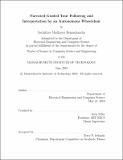| dc.contributor.advisor | Seth Teller. | en_US |
| dc.contributor.author | Hemachandra, Sachithra Madhawa | en_US |
| dc.contributor.other | Massachusetts Institute of Technology. Dept. of Electrical Engineering and Computer Science. | en_US |
| dc.date.accessioned | 2010-12-06T16:36:46Z | |
| dc.date.available | 2010-12-06T16:36:46Z | |
| dc.date.copyright | 2010 | en_US |
| dc.date.issued | 2010 | en_US |
| dc.identifier.uri | http://hdl.handle.net/1721.1/60100 | |
| dc.description | Thesis (S.M.)--Massachusetts Institute of Technology, Dept. of Electrical Engineering and Computer Science, 2010. | en_US |
| dc.description | This electronic version was submitted by the student author. The certified thesis is available in the Institute Archives and Special Collections. | en_US |
| dc.description | Cataloged from student submitted PDF version of thesis. | en_US |
| dc.description | Includes bibliographical references (p. 79-81). | en_US |
| dc.description.abstract | This work addresses the fundamental problem of how a robot acquires local knowledge about its environment. The domain that we are concerned with is a speech-commandable robotic wheelchair operating in a home/special care environment, capable of navigating autonomously to a verbally-specified location in the environment. We address this problem by incorporating a narrated guided tour following capability into the autonomous wheelchair. In our method, a human gives a narrated guided tour through the environment, while the wheelchair follows. The guide carries out a continuous dialogue with the wheelchair, describing the names of the salient locations in and around his/her immediate vicinity. The wheelchair constructs a metrical map of the environment, and based on the spatial structure and the locations of the described places, segments the map into a topological representation with corresponding tagged locations. This representation of the environment allows the wheelchair to interpret and implement high-level navigation commands issued by the user. To achieve this capability, our system consists of an autonomous wheelchair, a person- following module allowing the wheelchair to track and follow the tour guide as s/he conducts the tour, a simultaneous localization and mapping module to construct the metric gridmap, a spoken dialogue manager to acquire semantic information about the environment, a map segmentation module to bind the metrical and topological representations and to relate tagged locations to relevant nodes, and a navigation module to utilize these representations to provide speech-commandable autonomous navigation. | en_US |
| dc.description.statementofresponsibility | by Sachithra Madhawa Hemachandra. | en_US |
| dc.format.extent | 81 p. | en_US |
| dc.language.iso | eng | en_US |
| dc.publisher | Massachusetts Institute of Technology | en_US |
| dc.rights | M.I.T. theses are protected by
copyright. They may be viewed from this source for any purpose, but
reproduction or distribution in any format is prohibited without written
permission. See provided URL for inquiries about permission. | en_US |
| dc.rights.uri | http://dspace.mit.edu/handle/1721.1/7582 | en_US |
| dc.subject | Electrical Engineering and Computer Science. | en_US |
| dc.title | Narrated guided tour following and interpretation by an autonomous wheelchair | en_US |
| dc.type | Thesis | en_US |
| dc.description.degree | S.M. | en_US |
| dc.contributor.department | Massachusetts Institute of Technology. Department of Electrical Engineering and Computer Science | |
| dc.identifier.oclc | 679658740 | en_US |
